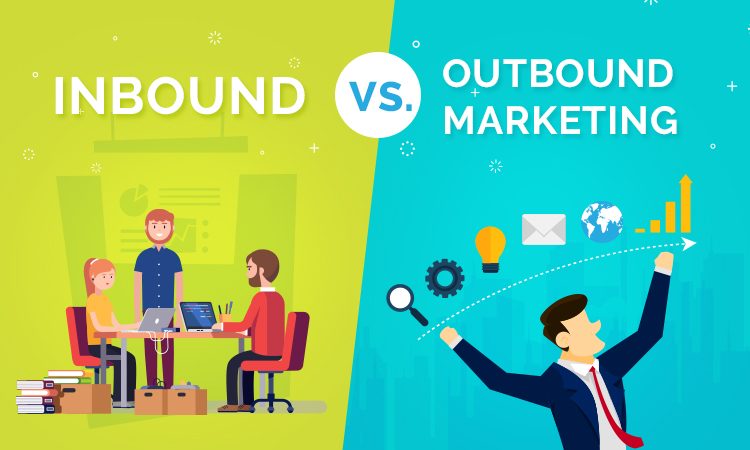Which is Better: Inbound vs. Outbound Marketing?
Since the infant days of marketing, enticing, appealing, and swaying the consumer to buy or interact with your product or service has been at the forefront of every economy. If you’re a business owner, startup, or marketpreneur, then you know in order to make money, you have to sell, and that usually means reaching into your arsenal of tools and tactics in order to construct a winning marketing strategy. Depending on the type of business, targeted audience, and a mountain of other factors, choosing the kind of marketing you need may end up being a little tougher than you think.
Is there a Difference? Inbound vs. Outbound
When people hear the words inbound and outbound marketing, many rarely understand the difference and assume it’s a fancy piece of industry jargon used to make proposals sound prettier. However, this is far from the truth, and there are some real deployable differences between the two. From their method, design, and implementation to their targeting, measuring, and type of distribution used, both inbound and outbound see several differences amongst another, but they both have a single common goal. CONVERT!
This brings forth another vital question. Which one is better at converting?
Pull Succeeds Where Push Fails
If you are unfamiliar with the terms push and pull, they both refer to the style of marketing both inbound, and outbound represent. Outbound marketing uses the push technique to distribute and target their leads, while inbound uses a method known as pull. Noticeably, the terms push and pull are contrasting words, which is similar to inbound and outbound marketing.
Pushing: Excuse me I was doing something
There was a time when outbound marketing was just marketing, and there were no different mediums that separated strategies. Now there are two marketing methods that companies use. Some use both, and some use one or the other in order to maximize their marketing efforts. Outbound marketing uses push marketing, meaning it pushes its message on any and everyone inside of the defined targeting zone, regardless of standpoint, demographic, or interest in your business. Due to oversaturation and shift in the market, there has been a considerable decline in click-thru rates for traditional banners and PPC ads used with outbound marketing according to the HubSpot’s State of Inbound 2017.
Forms of Outbound Marketing:
- TV & Radio Ads
- Telemarketing,
- Banner & Display Ads
- Billboards
- Print Mediums
- Pop-ups
Of course, there are a few others to name, but if you can see the pattern, every form of outbound marketing requires you to turn your concentration to the marketing efforts, halting current activities and daily progression. Outbound puts all of the power in the hands of the marketer or business, leaving very little room for the target to experience true brand value. Not all demographics are responsive to outbound tactics, seeing it has a huge distraction. Outbound marketing’s biggest take is that it looks at how customers can help your business.
Pulling: Sure, come on in, I can answer that
The idea of inbound marketing brings forth a way of thinking that in the beginning was looked at awkwardly. Inbound marketing looks at how your business or service can provide a level of usefulness to the consumer without being intrusive. Simply put, inbound marketing sets the company and brand in place for when the consumer needs it to solve a question or concern they have. This is referred to as the pull approach. It literally pulls customers to your brand by offering existing value. The equity of value can range from a well-made blog full of helpful Instructables to white papers that address more significant issues with in-depth research and data. This method of approach has become very popular, as stated in HubSpot’s piece mentioned above, where 71% of companies in 2017 confidently stated their main concentration is on inbound marketing.
Forms of Inbound Marketing:
- Blogs
- Infographics
- Email newsletters
- Social media
- Other content that sparks interest, shares, and impressions
While inbound marketing is sort of new in terms of coming to fruition with the explosion of digital media and social interactions. Through search engine optimization, paid promotion, and other paid search methods help to align the right people with your message when they are looking for it, not bombard them with gaudy pop-ups and other distracting advertisements. The inbound marketing approach is a hands-off system that once setup and put in place starts to work like a well-oiled machine. HubSpot presents a simple 4-step plan to how inbound marketing works:
- Attract- Uses blogs, keyword optimization, and social media publishing to attract and present brand value.
- Convert- Uses forms, Calls-to-Action, and landing pages to turn visitors into leads or prospects by presenting solution indicators to their problems or inquiries.
- Close- Uses CRM, email, and workflows to turn leads into customers by re-instilling your brand’s value and presenting clear solutions and answers for customers.
- Delight- Uses surveys, smart content, and social monitoring to ensure customers have the best experience by learning more and providing them with value based on audience trends. (customer-focused)
Tracking Down Which Type of Marketing Works Better for Your Business?
Through the implementation of SEO and other digital marketing techniques that make up inbound marketing have made it what it is today. By offering value on the back-end that is there when the customer wants it, not to mention it’s significantly cheaper than traditional outbound marketing. In fact, inbound marketing is 62% cheaper according to a study conducted by HubSpot, and it provides a much better ROI. Who doesn’t enjoy larger revenue margins? The real treat comes with the trackability of inbound marketing. From clicks, views, and impressions to overseeing key metrics like bounce, click-thru, shares, and new sessions to determine which portion of your loop needs improvement. Still have questions? Let’s sit down and talk about your business needs.


